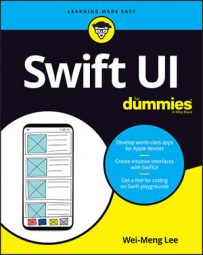Swift constants
In Swift, you create a constant using the let keyword:let radius = 3.45 // Double let numOfColumns = 5 // Int let myName = "Wei-Meng Lee" // StringNotice that there is no need to specify the data type — the data types are inferred automatically.
If you want to declare the type of constant, you can do so using the colon operator (:) followed by the data type, as shown here:
let diameter<strong>:Double</strong> = 8
After a constant is created, you can no longer change its value. Always use a let when you need to store values that do not change.
Swift variables
To declare a variable, you use the var keyword:var myAge = 25 var circumference = 2 * 3.14 * radiusAfter a variable is created, you can change its value. In Swift, values are never implicitly converted to another type. For example, suppose you’re trying to concatenate a string and the value of a variable. In the following example, you need to explicitly use the String() function to convert the value of myAge to a string value before concatenating it with another string:
var strMyAge = "My age is " + String(myAge)
To get the text representation of a value (constant or variable), you can also use the description property, like this: myAge.description.
Swift strings
One of the common tasks in programming is inserting values of variables into a string. In Swift, you use string interpolation and it has the following format:"Your string literal <strong>\(</strong><em>variable_name</em><strong>)</strong>"The following statement shows an example:
let firstName = "Wei-Meng" let lastName = "Lee" var strName = "My name is \(firstName) \(lastName)"You can also use this method to include a Double value in your string (or even perform mathematical operations or function calls):
var strResult = "The circumference is \(circumference)"
Swift comments
In Swift, as in most programming languages, you insert comments into your code using two forward slashes (//):// this is another commentIf you have several lines of comments, it’s better to use the /* and */ combination to denote a block of statements as comments:
/*
this is a comment
this is another comment
*/
Want to learn more? Check out our SwiftUI Cheat Sheet.
